 Weird Stuff
Weird Stuff  Weird Stuff
Weird Stuff  Our World
Our World 10 Ways Your Christmas Tree Is More Lit Than You Think
 Movies and TV
Movies and TV The 10 Coolest Stars to Set Sail on The Love Boat
 History
History 10 Things You Didn’t Know About the American National Anthem
 Technology
Technology Top 10 Everyday Tech Buzzwords That Hide a Darker Past
 Humans
Humans 10 Everyday Human Behaviors That Are Actually Survival Instincts
 Animals
Animals 10 Animals That Humiliated and Harmed Historical Leaders
 History
History 10 Most Influential Protests in Modern History
 Creepy
Creepy 10 More Representations of Death from Myth, Legend, and Folktale
 Technology
Technology 10 Scientific Breakthroughs of 2025 That’ll Change Everything
 Weird Stuff
Weird Stuff Ten Bizarre Facts About The Doge Meme
 Our World
Our World 10 Ways Your Christmas Tree Is More Lit Than You Think
 Movies and TV
Movies and TV The 10 Coolest Stars to Set Sail on The Love Boat
Who's Behind Listverse?

Jamie Frater
Head Editor
Jamie founded Listverse due to an insatiable desire to share fascinating, obscure, and bizarre facts. He has been a guest speaker on numerous national radio and television stations and is a five time published author.
More About Us History
History 10 Things You Didn’t Know About the American National Anthem
 Technology
Technology Top 10 Everyday Tech Buzzwords That Hide a Darker Past
 Humans
Humans 10 Everyday Human Behaviors That Are Actually Survival Instincts
 Animals
Animals 10 Animals That Humiliated and Harmed Historical Leaders
 History
History 10 Most Influential Protests in Modern History
 Creepy
Creepy 10 More Representations of Death from Myth, Legend, and Folktale
 Technology
Technology 10 Scientific Breakthroughs of 2025 That’ll Change Everything
Surgeons Who Made Miracles Happen
[Warning: Contains Sensitive Images] Our understanding of anatomy and physiology blossomed during the medical renaissance. Leonardo da Vinci’s many dissections provided a detailed overview of the human body; William Harvey discovered how the heart pumps blood around the body; and Hieronymus Fabricius made crucial discoveries relating to the reproductive, digestive, and nervous systems.
Today, we continue to build upon the foundations of this knowledge and apply it to modern surgery. Surgeons are now capable of achieving incredible feats of ingenuity. From nerve grafts to robot-assisted surgery, these advancements have saved lives and improved patient outcomes.
But, even in this most extraordinary of fields, some cases stand out. So, without further ado, let us explore just 10 occasions when surgeons went that extra mile and made miracles happen.
10 Fixing an Inside-Out Baby
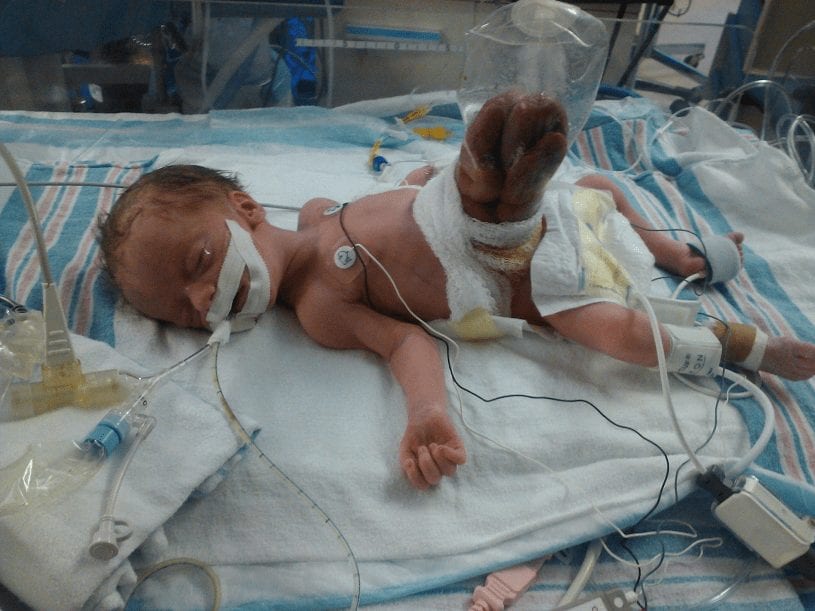
When expectant mother Melissa Thompson had her ultrasound scan, doctors noticed an unusual structure emerging from the baby’s belly. A defect in the baby’s abdominal wall had resulted in her intestines forming on the outside of her body. The condition – called gastroschisis – occurs when the intestines push through an opening next to the belly button.[10]
It was not long before complications arose. Doctors were concerned that baby Lily-Rae’s intestines, which were already starting to dilate, could rupture. The team delivered Lily-Rae three weeks early. She was immediately rushed to the operating room, where surgeons were tasked with putting her intestines back inside her body.
The team enveloped the intestines in a protective silo bag and left the rest to gravity. Over the ensuing weeks, Lily-Rae’s insides slowly sank back into to her body. But the family was dismayed to learn that parts of the intestines had died and turned black. Further surgeries were needed to remove the dead tissue. Lily-Rae was then fitted with two stomas – small openings in the abdominal wall that release waste from the body. Fortunately, the rest of the intestines received an adequate blood supply and survived. After five grueling months, Lily-Rae’s insides had returned to their rightful place. She was given the all clear and sent home.
9 Sculpting a Voice Box from Ribs
In 2016, Brooke Kilburn was involved in a car crash. Brooke, then 16 weeks pregnant, immediately booked an appointment with the obstetrician. An ultrasound scan revealed that her baby Cooper had a life-threatening medical condition called total laryngeal agenesis. The condition – only 50 cases of which have ever been documented – was completely unrelated to the crash. “If we hadn’t had that wreck it would have been too late for him,” said Kilburn.[9]
Total laryngeal agenesis occurs when the larynx fails to develop during the early stages of pregnancy. As a result, there was no way that Cooper would breathe normally outside of his mother’s womb. The doctors predicted that Brooke’s baby had a five percent chance of surviving birth. Brooke sought the expertise of surgeons at Le Bonheur Children’s Hospital in St. Louis. They came up with a step-by-step plan to deliver the baby safely.
A partial caesarean was carried out, whereby baby Cooper remained attached to his mother’s placenta. This would prove crucial. Since Cooper did not possess a proper airway, the placenta was still needed to supply him with oxygen. This gave surgeons enough time to give Cooper a tracheostomy, just before the full delivery took place.
Without a proper airway or larynx, Cooper spent years on a ventilator and could not speak. But Le Bonheur surgeons set about fashioning a voice box from two of Cooper’s ribs. Pediatric surgeon Ying Zhuge removed two ribs from the patient’s body during a 4-hour surgery. While Zhuge closed the incisions, ear, nose and throat surgeon Jerome Thompson set about reshaping the ribs. Each rib was arranged to form the front and back walls of the voice box. The new airway was then stitched into place and supported using a Teflon stent. After a nerve-wracking, six-week wait, the stent was removed. For the first time, Cooper could breathe without the aid of a ventilator. The team is now working on making an epiglottis to help Cooper eat properly.
8 Sewing a hand to a Patient’s Groin
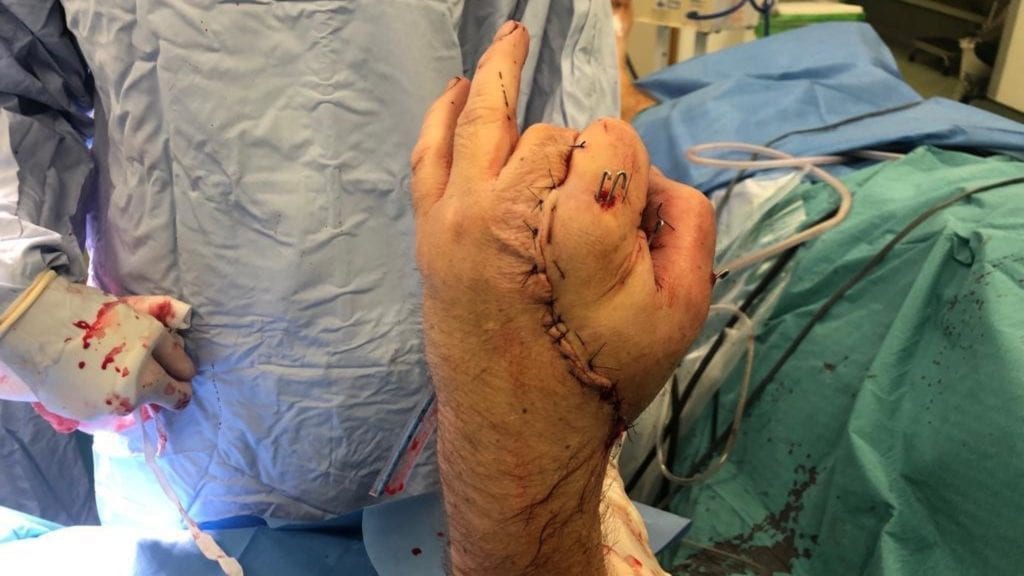
In 2019, a British carpenter from Walton-on-Thames had an unfortunate run-in with an electric chop saw. 46-year-old Anthony Lelliott caught his hand in the device while cutting planks of wood. The rotating blade tore into Lelliott’s hand, amputating his entire thumb and forefinger. “I don’t know whether it was my brain playing tricks on me, but it was like an out of body experience; I could see myself and see what I’d done. There was blood spurting out everywhere,” Lelliott said of the incident.
The Walton man was transported to St. George’s Hospital in Tooting, London. Surgeons battled for 17 hours to save Lelliott’s mangled hand. But time was running out. The surgical team worried that Lelliott’s detached fingers were starting to decompose.
During the first phase of the operation, Consultant Surgeon Roger Adlard worked to reattach the fingers. Adlard mended the broken bones, repaired the damaged ligaments, and performed tissue grafts from other parts of Lelliott’s body. He grabbed blood vessels and nerves from the carpenter’s foot and arm, respectively. The surgical team then used a very fine needle to stitch the blood vessels together and restore blood flow to the patient’s hand.[8]
As the operation drew to a close, it was clear that Lelliott’s middle finger was near unsalvageable. The decision was taken to remove the finger and use it to fix the man’s shattered palm. The team then moved on to perform a pedicled groin flap to replace the missing skin. The procedure involved surgically attaching the patient’s exposed palm to his own groin. After two weeks, the skin was perfectly healthy and Lelliott’s hand-to-groin surgery was reversed.
Lelliott is slowly regaining movement in his hand following a series of physiotherapy sessions. The lucky carpenter hopes to regain enough strength and dexterity so that he can return to work.
7 Eyeball Tattoos
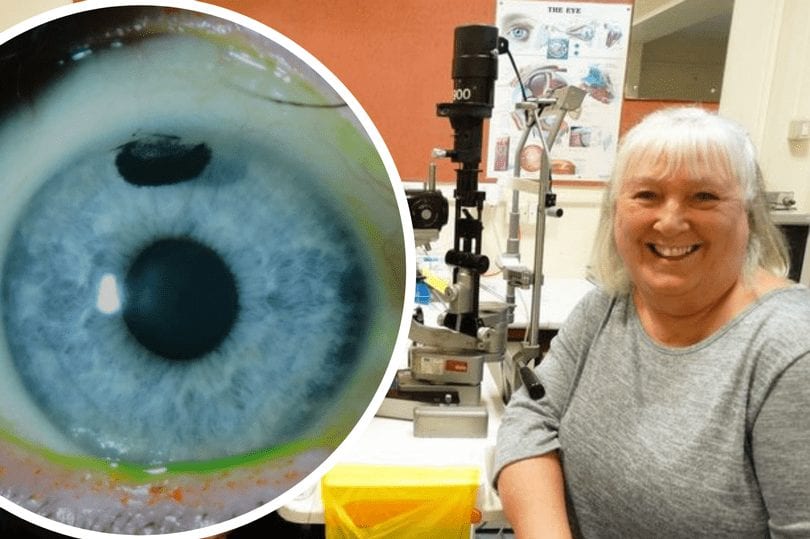
When Mandy Liscombe underwent laser eye surgery to treat her glaucoma, she had no idea the procedure would leave her with extreme sensitivity to light. More accurately, the laser treatment created an opening in the iris which was funneling extra light towards the light-sensitive retina. Because light was entering through both the pupil and the artificial hole, too many light rays were entering her eyes. This overload led to Mandy’s vision becoming obscured.
The artificial hole was created as part of the fix for Mandy’s glaucoma. Glaucoma is caused by the improper draining of fluid within the eye. This increases the pressure at the front of the eye, leading to visual problems and damage to the ocular nerve. The hole was designed to relieve the pressure by draining this fluid.
For years, Mandy sought treatment for her botched laser eye surgery. She could no longer watch TV properly, and fears grew over her fitness to drive. Car headlights completely distorted the 63-year-old’s vision. “Once headlights hit me, I really couldn’t see,” she explained.
But along came expert ophthalmologist Mario Saldanha. He created a small pocket in Mandy’s cornea, just in front of the artificial hole. He then filled this pocket with a tattoo ink, effectively blocking light rays from entering the wrong way. “It’s like having a filter in the clear window of her eye but without affecting the colored part, and retaining the artificial opening,” explained Saldanha.[7]
6 Helping a Three Year Old Walk
Victoria Komada was born with legs that were so badly deformed they bent backwards. The condition – bilateral tibial hemimelia – meant the 3-year-old was missing a number of bones in her lower legs.[6] Doctors believed that Victoria would never walk using her own legs and recommended she undergo a double amputation. But Victoria’s parents sought the advice of orthopedic specialists in the United States. They were told that a limb reconstruction procedure was possible, but it was expensive and surgeons would need to amputate one of Vicki’s legs.
The family organized a crowdfunding campaign to pay for the surgery. They raised a staggering $234,000 from communities in Britain and Poland. Victoria received treatment at the Paley Institute in West Palm Beach, Florida. During a 9-hour operation, surgeons amputated the right leg. A series of pins were then placed in the left leg, along with an adjustable fixator and strut. The screws were gradually turned each day to realign the bones. A second surgery, lasting six hours, fused the tibia and fibula of the remaining leg.
Working through the pain, Victoria strengthened her left leg and adapted to her new prosthesis. Thankfully, she can now walk, run, and play sports with her friends. “Now she is normal and she can do everything she wants,” explained Victoria’s father. “She has lots of shoes now.”
5 Making a Bladder from Bowels
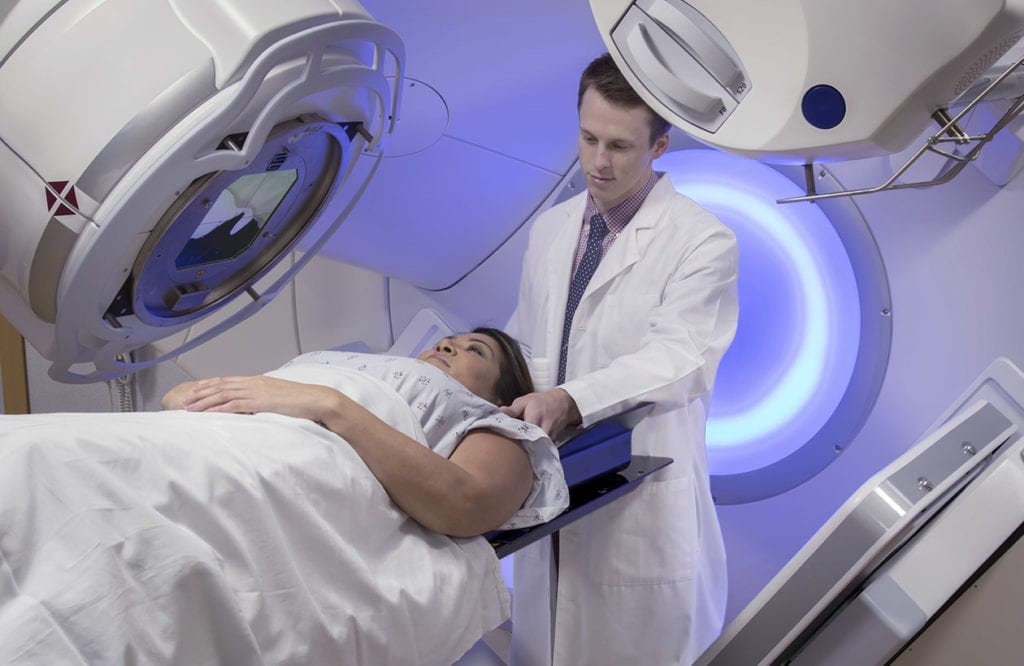
Surgeons at the University Hospital of Wales, Cardiff, constructed a new bladder from a woman’s bowels. Jessica Jenkins, of Rhymney Valley, South Wales, was diagnosed with cervical cancer when she was just 18. While successive rounds of treatment meant the cancer went into remission, Jessica’s bladder was badly damaged.[5]
Dozens of chemotherapy and radiotherapy sessions had shrunk Jessica’s bladder, making it small and inelastic. This put her at risk of developing kidney failure, meaning surgery was the only option left. Surgeons fitted stents to help with the passage of urine from the kidneys to the bladder. They eventually reconstructed Jessica’s bladder using tissue from her bowel.
But Jessica’s aggressive cancer treatments also rendered her infertile and in need of a surrogate mother. Thankfully, Jessica’s doctors had the foresight to freeze her eggs. The Welsh woman’s mother, Julie Bradford, agreed to carry Jessica’s baby to term. So, in 2016, the 45-year-old gave birth to her own grandson. The miracles of science may not end there, though. Jessica is now researching womb transplants in the hope that she might, one day, carry her own baby to term.
4 Crafting a Penis Implant
In 1978, Mohammed Abad fell under a moving vehicle while playing in the street. The 6-year-old was dragged along the road and sustained severe, life-changing injuries. Abad’s entire penis and left testicle were torn off during the incident.
But, in 2015, the Scottish man went under the knife to receive a penis implant, also dubbed a “bionic penis.” Abad’s new manhood took three years to make. A series of skin grafts were taken from his arm and used to sheath a mechanical cylinder. As part of an 11-hour procedure, surgeons at University College London attached the implant to Abad’s pubic area. They then wired the implant to a controller located in his scrotum. At the press of a button, fluid is fed from a saline reservoir into the penis implant, causing it to swell.[4]
Abad was quick to try out his new appendage. He made contact with British political candidate and sex worker Charlotte Rose. The two booked a hotel room together and tested out the bionic penis. The first night ended in disaster after Abad’s penis pump failed. The technical hiccup was fixed the next day, allowing Abad to make love for an impressive two hours.
But Abad, now capable of achieving an 8-inch erection, faced a different dilemma. Abad’s sexual partners now complained that his penis was too large. In 2016, he opted to undergo another surgery to reduce the size of his implant.
3 The 25-Hour Face Transplant
In 2016, Cameron Underwood shot himself in the head in an attempt to end his own life. The gunshot obliterated Underwood’s face, leaving his jaw, nose, and cheeks severely damaged. Initial attempts to reconstruct his face proved difficult. Because the 26-year-old Californian was missing large parts of his face, he struggled to perform simple tasks like eating and talking.
A year later, Cameron was placed on a waiting list for a face transplant. The donation came from 23-year-old William Fisher, a John Hopkins student who succumbed to his own mental health issues. “I am thankful that, in honoring his decision, we were able to give life to others,” explained Fisher’s mother. “I don’t think I would have survived Will’s death if not for Cameron. Cameron has his whole life ahead of him – and I love the idea that Willie is helping him have a better life.”
The transplant, which took place at NYU Langone Medical Center in New York, required the expertise of over 100 healthcare professionals. Dr. Eduardo Rodriguez’s team spent 25 hours restoring Cameron’s lips, jaw, gums, teeth, tongue, and lower eyelids.[3] 3D-printed cutting guides were used to cut the donor’s facial skeleton, producing a graft that complemented the missing portion of Cameron’s face. Surgeons secured the new graft to Cameron’s face using titanium screws and covered it with the donor’s soft tissue.
2 Giving a Patient Two Hearts
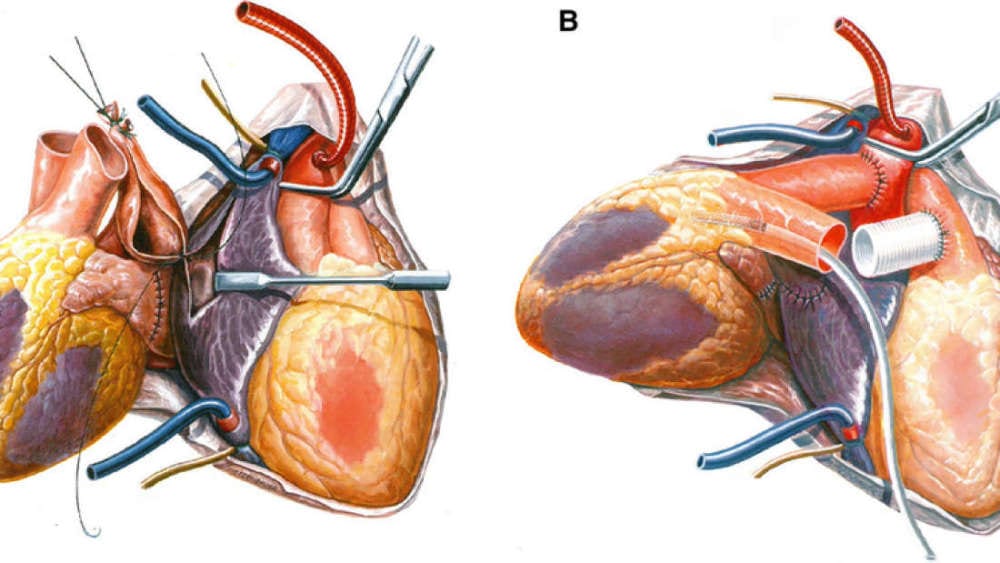
In 2011, surgeons at UC San Diego Center for Transplantation used an unusual technique to remedy a San Diego man’s heart failure. The procedure, known as a heterotopic heart transplant, involved installing a second heart into the patient’s chest cavity.
Tyson Smith’s heart failure meant the left ventricle of his heart could no longer efficiently circulate blood around his body. Surgeons could not simply perform a regular heart transplant – replacing the failing heart with a new one – due to Smith’s pulmonary hypertension. The muscle within the right ventricle of Smith’s old heart had thickened to compensate for the resistance to the flow of blood within his lungs. Any new heart would lack this powerful muscle and struggle to deliver blood to the lungs. This would lead to the new heart failing very quickly.
To overcome this problem, expert cardiac surgeon Jack Copeland connected Smith’s old heart to his new one. His old heart, along with its powerful right ventricle, continues to deliver deoxygenated blood to the lungs. Meanwhile, the left ventricle of the new heart pumps oxygenated blood around Smith’s entire body, effectively replacing the failing left ventricle of the old heart.
Tyson Smith went on to make a full recovery and is now the proud owner of two beating hearts.[2] The transplant was successfully completed on Valentine’s Day.
1 Removing Half a Brain
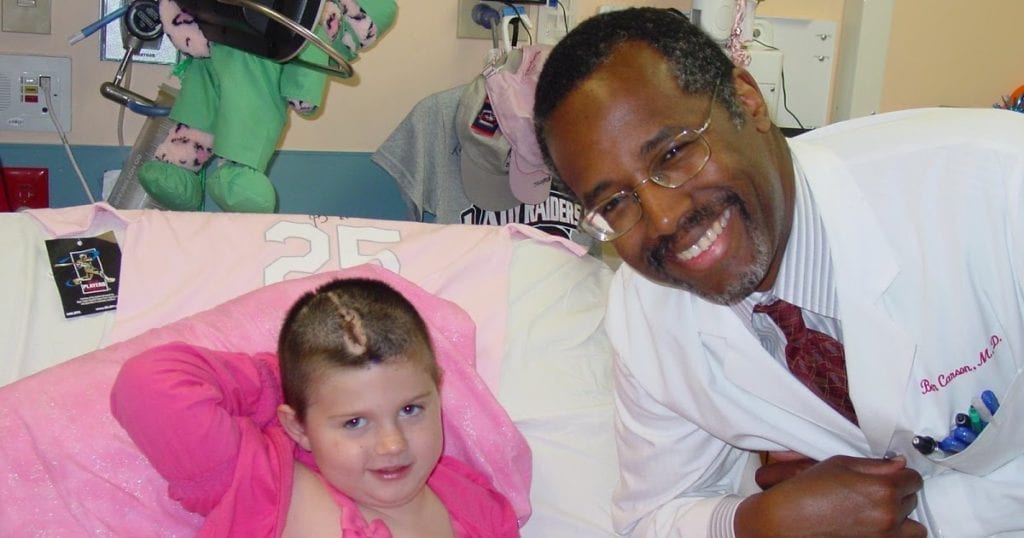
Jessie Hall suffered frequent seizures as a youngster. The debilitating condition, which Jessie’s parents called “The Monster,” impaired the girl’s movement and resulted in uncontrollable twitches. As it turned out, the Texas girl had a rare neurological condition called Rasmussen encephalitis. The exact cause of the disease remains a mystery. However, researchers believe that Rasmussen stems from a dysfunctional immune system, which attacks the cerebral cortex of either the left or right hemisphere of the brain.[1] The affected hemisphere then begins to waste away, causing speech problems, partial paralysis, and a loss of motor control.
The family sought treatment from Dr. Ben Carson at John Hopkins Hospital in Baltimore. Carson, who is currently serving as the U.S. Secretary of Housing and Urban Development, once specialized in removing diseased hemispheres of the brain. As part of a 7-hour operation, Carson and colleagues removed the entire right half of Jessie’s brain. In most cases, the remaining half of the brain assumes the role of its missing counterpart and the condition resolves itself.
Following the operation, Jessie experienced weakness in her arm and impaired vision. But weeks of intense physiotherapy eventually paid off. She went on to make an astonishing recovery and now lives a normal, seizure-free life. In 2015, Jessie addressed a crowd at an international hemispherectomy conference: “Don’t give up. Keep trying. If you do it wrong, fix it.”
Check out more fascinating medical tales on Top 10 Strange Medical Conditions That Really Exist and 10 Of History’s Most Evil Medical Murderers.








